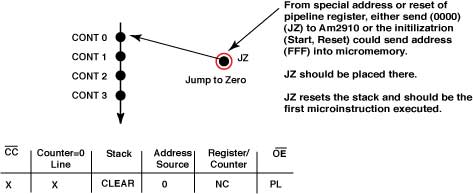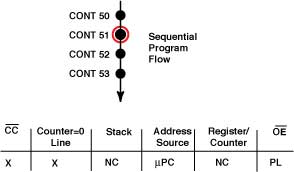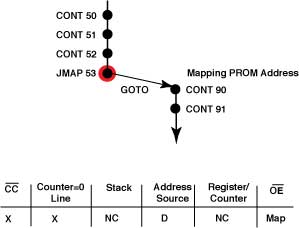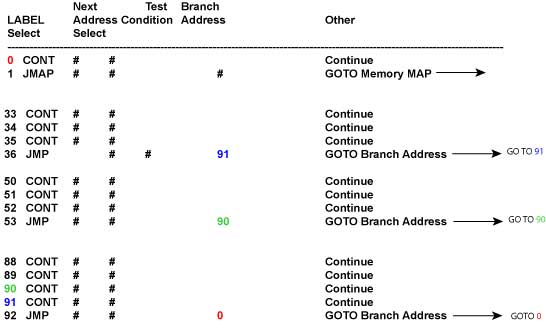|
Preface
Table of Contents
1. Introduction
2. Simple Controllers
3. Adding Programming
Support to the Controller
4. Refining the CCU
- Status Polling
- Interrupt Servicing
- Implementation -
Interrupt Request
Signals
- Vector Mapping
PROM
- Next Address Control
- Am2910
- Am2910 Instructions
- JZ, CONT, JMAP
- CJP, CJV, LDCT, JRP, CJS
- JSRP, CRTN, RPCT, PUSH
- LOOP, CJPP, TWB
- Control Lines
- Interrupt Handling
- Am2914
- Interconnection of
the Am2914
5. Evolution of the
ALU
6. The ALU and Basic
Arithmetic
7. Tying the System
Together
Glossary
|
Refining the CCU
Last Edit November 2, 1996; May 1, 1999; July 7, 2001
Am2910 Instructions
Table 4-1 Am2910 Instructions
Instruction
Mnemonic |
Behavior |
Binary Code |
| JZ |
Jump to Zero |
0000 |
| CJS |
Conditional jump to subroutine using pipeline register address |
0001 |
| JMAP |
Jump to Map (mapping PROM input) |
0010 |
| CJP |
Conditional jump to address in pipeline register |
0011 |
| PUSH |
PUSH stack; conditional load counter |
0100 |
| JSRP |
Conditional jump to subroutine from piepline register address
if tru, use pipeline address, if false, use register/counter
address (continue) |
0101 |
| CJV |
Conditional jump to vector mappin PROM address |
0110 |
| JRP |
Conditional jump to register or pipeline |
0111 |
| RFCT |
Repeat loop stack address until counter not 0 |
1000 |
| RPCT |
Repeat loop pipeline address until counter not 0 |
1001 |
| CRTN |
Conditional Return |
1010 |
| CJPP |
Conditional jump to Subroutine and POP stack |
1011 |
| LDCT |
Load counter and continue |
1100 |
| LOOP |
Test for end of loop. If fails, repeat loop |
1101 |
| CONT |
Continue |
1110 |
| TWB |
Three-way branch |
1111 |
Jump Zero (JZ)
Jump to Zero: Power-up or restart sequences need to
use the Jump Zero instruction if the stack is to be used anywhere
in the microprogram. JZ resets the TOS pointer to binary 0.
JZ may be made to execute in various ways.
If a pipeline is being used, resetting the pipeline register
to all zero sends 016 as the hex code for the instruction
word. Since 016 = JZ (0000), the Am2910 executes
JZ. A reset, restart or power-up control should cause the pipeline
to reset.
Where the pipeline on the PROM memory does not exist, the OE'
control on the Am2910 can be used with 10K pull-up resistors
to force FFF16 on the address lines into the PROM
memory. The JZ instruction should be placed at this location.
This approach requires and extra microword in the memory, which
is not usually a problem. Either of these appraoches is satisfactory.
JZ does not alter the register/counter, which is assumed to
be undefined until reset. Any reference to the register/counter
prior to a load instruction will result in unpredictable behavior.
The pipeline is left enabled in this instruction. With the exceptions
of instructions JMAP and CJV, the pipeline is left enabled to
improve execution speeds. A flow diagram for JZ is shown in
Figure 4-9.
Figure 4-9 Jump zero (JZ, 0, 0000)

All instructions pass the next-address select bits, which include
the Am2910 instruction field, the condition code multiplexer
select bits, and any additional control pin fields (RLD', CCEN').
All instructions cause a next-address value to be switched through
the next-address multiplexer and to be incremented by the incrementer.
Continue (CONT)
Sequential Execution: Sequentional program segments
use the Continue statement, whose flow is shown in Figure
4-10. The µPC register is the source of the next-address.
The register/counter and the stack are not altered. The CC'
input is unused. The pipeline output enable PL' is enabled.
Figure 4-10 Continue (CONT, E, 1110)

Jump Map (JMAP)
Jump to the Map address: JMAP is trhe instruction used
to start different microroutines based on opcode decode, and
a mapping PROM or the equivalent construct. This GO TO branches
to the address appearing at the Di inputs, and the
MAP' output enable is active. In a CCU such as the one being
discussed, this will gate the address output by the mapping
PROM into the Am2910. The register/counter and stack are not
affected. This statement is normally placed at the end of a
microroutine or placed at a case-branch (jump-op) location in
the microprogram (see Figure 4-11).
Figure 4-11 Jump map (JMAP, 2, 0010)

Figure 4-12 Sample Code for CONT, JMAP, JMP

Continue
|
|



